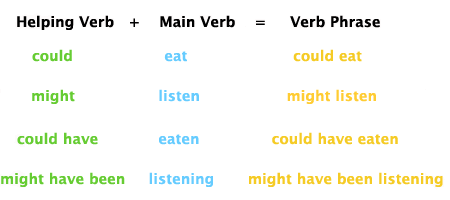A verb of more than one word is called a verb phrase. It is a phrase consisting of a verb, its auxiliaries (helping verbs), its complements, and other modifiers. Auxiliary verbs always come before the main verb.
A verb phrase is a syntactic unit that corresponds to the predicate. There are two types of auxiliary verbs. Inflected auxiliary verbs e.g. be, have, do and Modal auxiliary verbs e.g. will, should, must etc.
Verb Phrase Examples
Below are some verb phrase examples with explanation:
* She has taken the job. (Auxiliary has + main verb taken)
* Mom is making the room. (auxiliary is + main verb make)
* He did sing at the party. (auxiliary do + main verb sing)
* He has been coming late everyday. (auxiliaries has been + main verb take)
In a VERB PHRASE (VP), the Head is always a verb. The pre-Head string, if any, will be a `negative' word such as not [1] or never [2], or an adverb phrase [3]:
[1] [VP not compose an aria]
[2] [VP never compose an aria]
[3] Paul [VP deliberately broke the window]
Many verb Heads must be followed by a post-Head string:
My son [VP made a cake] -- (compare: *My son made)
We [VP keep pigeons] -- (compare: *We keep)
I [VP recommend the fish] -- (compare: *I recommend)
Practice Exercise #1
Underline the verb phrase:
She kept working like a machine.
They were being exploited.
Life goes on.
I came across these old books today.
Her new dress fell apart in the washing machine.
My little brother has always looked up to me.
No one gets away with murder.
Take off your clothes and jump in the lake.
We have to work out a plan to handle this situation.
It is difficult to wake up very early every day.
I threw the dirty ball away from the bag.
Practice Exercise #2
Directions: In
the following sentences, underline the subject of the sentence and double
underline the complete verb phrase. Label the subject (s), helping verb (hv), and main
verb (mv)
- Chocolate has been loved for many centuries.
- I am not sure for how long exactly.
- Some people might store their chocolate in the refrigerator.
- Chocolate should be served at room temperature.
Exercise # 3
Look at the model.
A
logo is not
your brand, nor is it your identity.
Noun
phrase: A logo
Head noun: logo
Pre-modifiers: a
Post- modifier: -
Verb
phrase: is not your brand, nor is it your identity.
Head verb: is
Helping verb: -
Verb tense: is Simple
Present
Now, check the following sentences and Label the noun phrase (NP), head noun (HN), pre-modifier (PreM), post modifier (PostM) Verb phrase (VP) Head verb (HV), helping verb (hv), and main verb (mv).
1.These guidelines ensure that the identity of the company is kept coherent, which in turn, allows the brand as a whole, to be recognisable.
2. A logo does not sell the company directly nor rarely does it describe a business.
Workshop
- Look for an article related to your field of expertise. Use Google, write key words related to a topic you want to read about.
- Write a post in your blog. Introduce the topic of the article. Make sure to add the link where you got it from. Write a short summary of the article. Say what it is about.Give your opinion about it.
- Select two paragraphs from your article and copy them in your blog.
- Find three sentences and underline the complete verb phrases. Verb phrase (VP) Head verb (HV), helping verb (hv), and main verb (mv)
- Also, Label the noun phrase (NP), head noun (HN), pre-modifier (PreM), post modifier (PostM) Verb phrase.
Keep on shining love and peace!


No comments:
Post a Comment